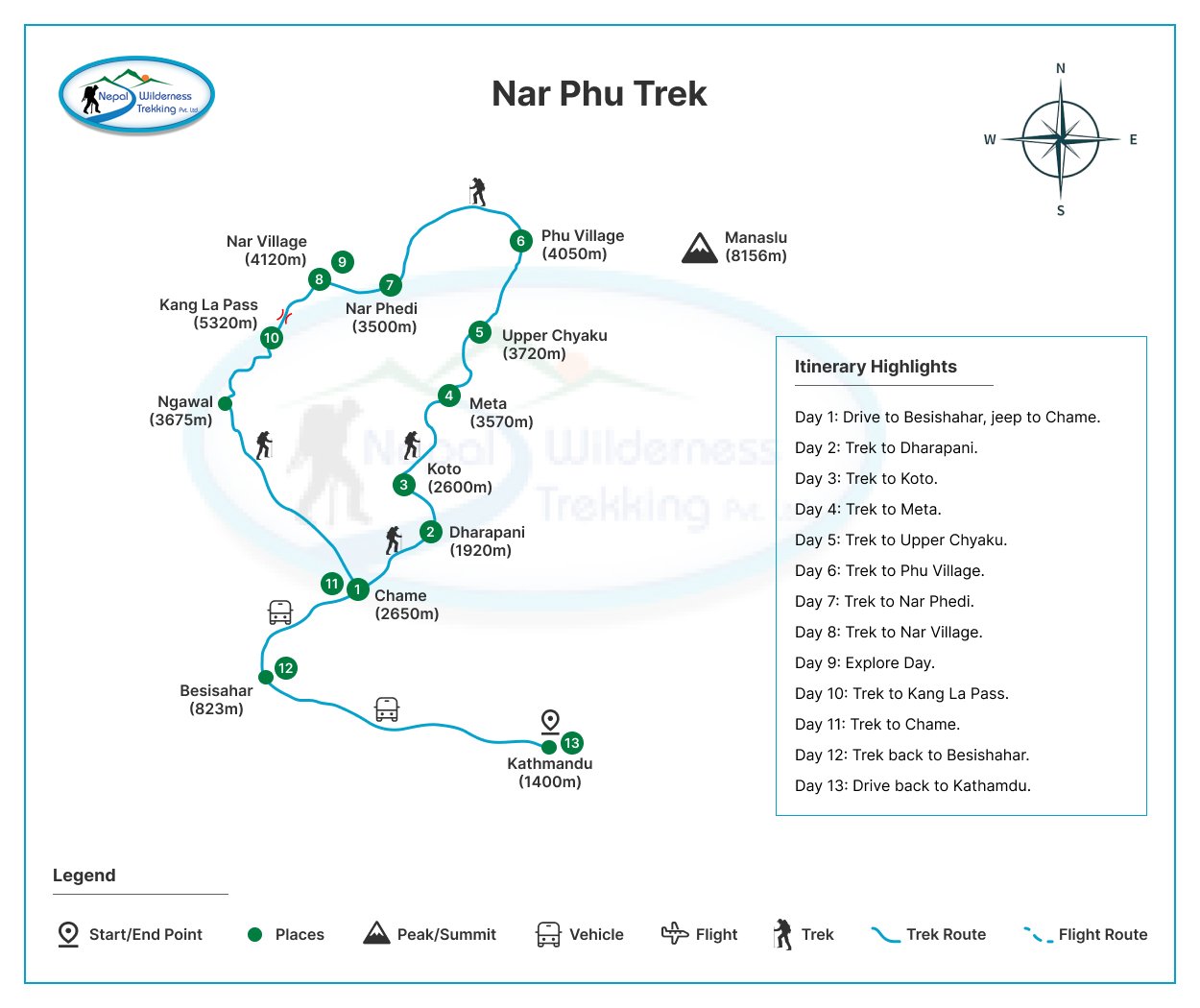
Nar & Phu Trekking
Thank you so much for organizing our trip Nar And Phu Valley, we had the perfect time with our guide Bir Gurung, and I will recommend Nepal Wilderness trekking and guide Bir Gurung.
see you Himal next time
Since the terrain can be hard and the days long, hikers on these treks should be in good physical condition and have some previous mountain walking experience. Steep climbing may be involved, although it is never necessary to use ropes. Treks at this level can he arranged for periods of 16 to 21 days. Typically, a gradual ascent through a green river valley will lead you up to a number of high passes, where you will reach the altitude of 5416m. Often times, you will get a close insight into the Tibetan culture. Participants should expect to trek above 5416m/17872ft.
Hold Your Guide : Suk Bahadur Ghale100%
The Nar Phu Valley Trek is a hidden gem in the Annapurna region, providing adventurers with a unique and unforgettable experience in the remote corners of the Himalayas. This relatively new trekking route unveils breathtaking landscapes and takes you off the beaten path, allowing you to explore less-traveled areas that are teeming with natural beauty and cultural richness. Get ready for an extraordinary adventure that will leave you with memories to cherish for a lifetime.
Nestled on the Tibetan border, Nar and Phu are two ancient villages amidst the breathtaking Annapurna Himalayas. The valley boasts lush forests and high-altitude grazing settlements, showcasing an array of diverse flora and fauna. As one of Nepal’s most beautiful and untouched regions, it promises to captivate your senses. Trekkers also arrive in Phu village via the Terila Pass and Saribung Pass, adding to the allure of this remote and enchanting destination.
As you embark on this incredible Nar Phu trek, you’ll witness the contrasting lifestyles of the Khampas – Tibetan refugees residing in Nar and Phu. These villages are not only geographically distinct but also boast unique cultural identities. Marvel at the glory of Chortens and observe herds of rare blue sheep, adding a touch of wilderness to your expedition.
The Nar Phu Valley Trek offers an exciting and challenging journey for adventure seekers. Surrounded by dramatic peaks and snow-capped summits, this isolated region is a sanctuary of natural beauty. Your heart will race as you conquer the high alpine valleys above Phu, with the option to venture to the Himlung base camp for those seeking even greater thrills. Crossing the Kang La pass at 5300 meters will leave you with an indelible sense of accomplishment.
The Nar Phu Valley is a treasure trove of ancient Buddhist monasteries, some dating back over a thousand years. Immerse yourself in the spiritual and social activities centered around these revered monastic sites. Witness the locals donning traditional woolen chubas and intricate Topi hats, showcasing their distinct cultural identity. Throughout the year, vibrant festivals like the Mani Rimdu festival breathe life into the valley, offering a mesmerizing glimpse into their rich traditions.
The Nar Phu Valley trek is a stunning and less-traveled route in the Annapurna region of Nepal. The distance of the trek can vary depending on the specific itinerary chosen and any side trips taken along the way. Typically, the Nar Phu Valley trek covers around 75-80 kilometers (around 47-50 miles) in total, taking about 10-12 days to complete. However, this can vary depending on factors such as starting point, hiking speed, and side excursions.
You cannot trek the Nar Phu Valley route without a guide due to the area’s restricted status in Nepal. You must obtain permits for accessing Nar Phu Valley through licensed guides from authorized trekking agencies. Attempting the trek independently violates the regulations governing restricted regions. Guides ensure compliance with permit requirements, provide navigation assistance, and enhance overall safety. Trekking with a guide not only ensures adherence to regulations but also improves the trekking experience with local insights and support.
Whether you’re a seasoned trekker or a first-time adventurer our site has only 13 days, however, Nar phu trek itineraries cater to your preferences and time frame. Our experienced Sherpa guide team and porters are committed to promoting rural harmony in the remote villages along the northern shore of the Annapurna region. English and local language-speaking guides ensure that every step of your journey is enriched with cultural insights.
Experience the unique charm of the Nar Phu Valley trek with Nepal Wilderness Trekking Pvt. Ltd. As a local company, we pride ourselves on offering competitive rates while ensuring your utmost satisfaction. By choosing us, you not only embark on an unforgettable journey but also contribute directly to the local community, making a positive impact on their livelihoods. Moreover, our deep local knowledge enhances your adventure, providing rich insights and unforgettable experiences. Discover the beauty of Nar Phu Valley with us, and leave a lasting imprint on both your heart and the lives of the people you encounter along the way.
The price for the Nar Phu trek can vary depending on several factors such as the duration of the trek, the services included (such as guide, porter, accommodation, meals, transportation), and the trekking agency chosen. On average, trekkers can expect to budget anywhere from USD 1200 to USD 1500 per person for the Nar Phu trek, excluding international flights and personal expenses. Choosing a local trekking agency like Nepal Wilderness Trekking Pvt. Ltd. can often provide competitive rates without compromising on quality.
The Nar Phu Valley Trek is open year-round. While the peak tourist seasons of March to May and September to November are ideal for most trekkers. Adventurous souls can also explore the valley during the monsoon season (June to August). Experience the charm of this untouched landscape, though access to Besisahar may be affected by mud and landslides during the monsoon.
The Nar Phu Valley Trek is a journey of challenges and rewards, allowing you to discover hidden valleys, meet hospitable locals, and witness awe-inspiring landscapes. This is an experience that will leave an indelible mark on your heart and soul.
Please note that single trekkers cannot obtain permits for the Nar Phu Valley Trek due to the Restricted Area regulations. It’s important to be aware of this restriction and plan accordingly.
| Trip Dates | Trip Price | Confirmed Pax | Trip Status | |
|---|---|---|---|---|
| July 28, 2024 | US$ 1100 | Join a Group | Book Now | |
| August 4, 2024 | US$ 1100 | Join a Group | Book Now | |
| August 10, 2024 | US$ 1100 | Join a Group | Book Now | |
| August 16, 2024 | US$ 1100 | Join a Group | Book Now | |
| August 22, 2024 | US$ 1100 | Join a Group | Book Now | |
| August 28, 2024 | US$ 1100 | Join a Group | Book Now | |
| September 4, 2024 | US$ 1100 | Join a Group | Book Now | |
| September 10, 2024 | US$ 1100 | Join a Group | Book Now | |
| September 16, 2024 | US$ 1100 | Join a Group | Book Now | |
| September 22, 2024 | US$ 1100 | Join a Group | Book Now | |
| September 28, 2024 | US$ 1100 | Join a Group | Book Now | |
| October 4, 2024 | US$ 1100 | Join a Group | Book Now | |
| October 10, 2024 | US$ 1100 | Join a Group | Book Now | |
| October 16, 2024 | US$ 1100 | Join a Group | Book Now | |
| October 22, 2024 | US$ 1100 | Join a Group | Book Now | |
| October 28, 2024 | US$ 1100 | Join a Group | Book Now | |
| November 4, 2024 | US$ 1100 | Join a Group | Book Now | |
| November 10, 2024 | US$ 1100 | Join a Group | Book Now | |
| November 16, 2024 | US$ 1100 | Join a Group | Book Now | |
| November 22, 2024 | US$ 1100 | Join a Group | Book Now | |
| November 28, 2024 | US$ 1100 | Join a Group | Book Now | |
| December 4, 2024 | US$ 1100 | Join a Group | Book Now | |
| December 10, 2024 | US$ 1100 | Join a Group | Book Now | |
| December 16, 2024 | US$ 1100 | Join a Group | Book Now | |
| December 22, 2024 | US$ 1100 | Join a Group | Book Now | |
| December 28, 2024 | US$ 1100 | Join a Group | Book Now |
